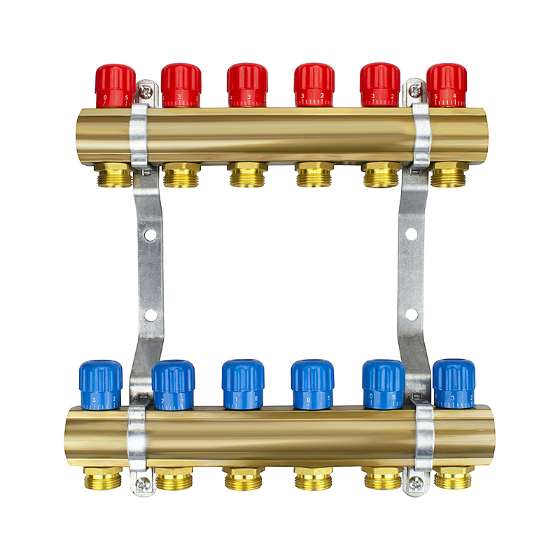Radiant heat manifold
Radiant heat manifold is an element commonly used both in industrial and residential buildings. You can use it in a traditional radiator central heating, as well as in underfloor heating system.

Radiator manifold
When creating the underfloor heating manifold, we focused primarily on the precision and durability, which are a guarantee for many years.

Underfloor heating manifold
Thermal comfort is one of the key aspects of every building. It greatly depends on using new technologies and proper equipment.
Modern equipment - manifold for central and underfloor heating
Thermal comfort is one of the key aspects of functioning of every building. It highly depends on using new technologies, as well as its proper installation. Easy maintenance of the devices used in various rooms is another important matter for most of the users. A radiant heat manifold is an element used nowadays both in industrial and residential buildings. It can be applied to traditional radiator central heating as well as to underfloor heating systems.
Underfloor heating system - a manifold instead of radiators
Underfloor heating system is a good alternative for traditional heating solutions. Contrary to the classic systems, this one does not require the installation of radiators on the walls. Instead, a special system is installed under the floor, which provides a proper thermal comfort - either in the whole building or in designated zones.
The most important issue, in this case, is a proper design and planning - particularly aspects such as arrangement of each element of the system. A radiant heat manifold is one of those elements. If it's possible, it's best to create a project at the stage of the building's construction. This is also the moment when one chooses the method of supplying the system. One can choose either water of electric underfloor heating.
The first of those options is definitely more popular, as it is more economical. The principle of operation here is quite simple. The conduits of a water underfloor heating system are heated up to lower temperatures in comparison to traditional radiators. Despite this fact, the temperatures are the same in both cases. It means that in a room with a PEX manifold, the level of warmth is exactly the same as in the one with radiators. However, the energy consumption is much lower in the first case.
Why should you choose underfloor heating?
An increasing number of homeowners appreciate the advantages of underfloor heating systems. To begin with, it's a system that responds perfectly to the biological needs of a human being. Because the heat first gets to the lower parts and travels upwards in a regular manner (thanks to a manifold) - it provides a proper thermal comfort to a human body.
Furthermore, underfloor heating systems are highly recommended to allergy sufferers. By eliminating radiators, one can reduce the dust accumulation in a room. It also removes the problem of air movement. Allergens are not pulled upwards, so they cannot enter one's respiratory system.
However, the proper functioning of such a system highly depends on its proper construction and use of elements such as a manifold. Picking the right type of equipment reduces the need of its maintenance. It also increases durability of the installation for a long time - regardless where it has been placed.
A manifold - the basic element of an underfloor heating system
A manifold is a necessary invention that greatly influenced the quality of underfloor heating systems. First and foremost, it improves the efficiency of heating. A manifold also prevents the floor from overheating at particular spots. The heat spreads evenly across the whole surface where the system has been installed. Therefore, one could say that a manifold helps to balance the whole installation. Thanks to this, the system is efficient and works properly.
There are many types of such equipment available on the market. Manifold models for underfloor heating can differ by material, accessories and number of sections. One should consider all of those elements when designing a heating system.
Radiant heat manifold for underfloor heating - how does it work?
Water underfloor heating systems are unique, as they use a lot of layered pipes, which form loops. Each of them is supposed to supply heat to a particular area. What's important, the loops are not even - they can have different lengths. It's directly connected with water flow on a given area. A properly working system depends on using equipment such as radiant heat manifold with control valves. They allow for control over the flow of the liquid through the system.
Radiant heat manifold for a radiator - what is it?
Apart from underfloor heating, radiators are still used in some cases. Those two solutions can be used simultaneously in one building. One can connect a radiator with a manifold - so that one has control over all radiators in the building. In case one of them malfunctions and needs repair - manifold allows for cutting the supply just in one of the circuits. The rest of the heating systems will work as usual.
